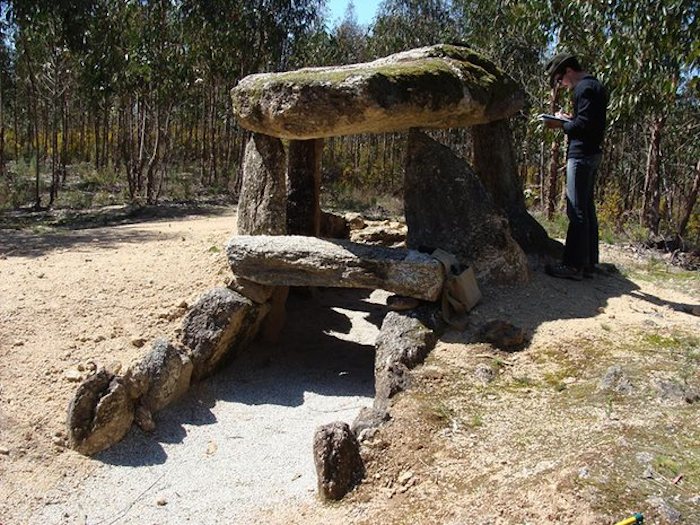.

The orientation of the tombs suggests that they are aligned to offer a view of Aldebaran, the brightest star in the constellation of Taurus. Photograph: University of Wales Trinity Saint David/Nottingham Trent University
-
The prehistoric tombs that may have been used as 'telescopes'
Researchers think that the entrance passages to 6,000 year-old tombs could have been used to enhance visibility for ancient stargazers
-
Ancient passages to stone tombs could have been used by prehistoric humans to boost their view of the night skies as part of an ancient ritual, archaeologists have proposed.
Researchers say that the dark entrances to 6,000 year-old tombs in Portugal could have been an early form of astronomical tool that enhanced the visibility of the stars. In particular, they say, the orientation of the entrances to the passage graves suggests that they are aligned to offer a view of Aldebaran, the red star that is the brightest body in the constellation of Taurus.
The star might have been important to ancient communities who moved their herds and flocks to summer grazing grounds in the mountains each year. The annual event, the researchers argue, could have coincided with the star’s first appearance in the morning twilight each year. “This first rising of Aldebaran occurred at the end of April or beginning of May 6,000 years ago, so it would be a very good, very precise calendrical marker for them to know when it was time to move into the higher grounds,” said Dr Fabio Silva of the University of Wales Trinity Saint David.
.

The passageway’s long corridor acts like a telescope without a lens, says Dr Fabio Silva. Photograph: University of Wales Trinity Saint David/Nottingham Trent University
-
The team, including researchers from Nottingham Trent University, believe the conditions within the tunnels could have provided viewers with a chance to spot Aldebaran’s first appearance before those outside.
That, they say, could have been linked to ancient rituals in which individuals were left on their own in the tomb with the remains of their ancestors. “There is a wealth of evidence now that these passage graves were not only used as tombs for burials, but they could also be used for rites of passage,” said Silva. Such rituals, he adds, often involved the revelation of an astronomical secret to the initiate. “Could the secret be that he could see the star rising days, if not a full week, before everybody else that was outside the passage grave could see it?” said Silva.
Presenting their work at the Royal Astronomical Society’s National Astronomy Meeting at the University of Nottingham, the team propose that the corridors boast a number of features that would have allowed someone within them to glimpse an early view of Aldebaran’s so-called heliacal rising through the small window provided by the tunnel’s opening.
“The key thing is that a passage grave with its long corridor acts like a telescope that does not have a lens - it is a long tube from which you are looking at the sky,” said Silva. “Its characteristics are going to impact how you are looking at the sky in three or four ways.”
Among these, says Silva, the corridors point towards the horizon, focusing the viewer’s attention on one area of the sky, while the walls would block out the pre-dawn rays from the sun, making it easier to spot other celestial objects and increasing the contrast with the sky. The viewer’s eyes, he adds, would be adapted to the dark of the passage, potentially making them better adjusted to spotting faint stars.
“All you are doing is making sure everything is dark apart from that small area in the sky,” said Dr Daniel Brown from Nottingham Trent University, who is also involved in the research.
Silva and the team are currently testing these ideas by simulating the conditions of the passages in the laboratory.
.

The researchers suggest that there may have been a ritual significance to viewing the night sky from the tombs. Photograph: University of Wales Trinity Saint David/Nottingham Trent University
-
“We are going to simulate this star rising at twilight conditions and allow people to tell us when they can see it,” said Silva. “Then [we will] compare that with a control group of people that are in a room which would replicate the conditions of being outside the passage grave.”
The link between ancient sites and astronomy is far from new - Stonehenge being perhaps the most famous example. But the purpose of such sites is notoriously difficult to unpick.
“As any archaeologist will tell you, trying to understand what was going through the minds of the people who built these prehistoric monuments is a difficult task,” said Dr Marek Kukula, public astronomer at the Royal Observatory Greenwich. “But this team is carrying out a fascinating study into how the human visual perception of a small patch of sky can be affected by the narrow views along the passages of the Portuguese structures.”
While the team propose that such properties could have had calendrical and spiritual purposes, Kukula believes the work highlights the central role of stargazing in societies throughout time.
“Whether these really were were the reasons why the passage tombs were originally built is hard to say for sure,” he said. “But this kind of ‘archaeoastronomy’ highlights the fact that human beings have always been fascinated by the stars and that sky-watching has had an important role in human society for millennia.”
Quelle: theguardian
4864 Views
